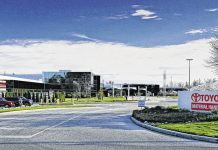BUTLERVILLE — In an effort to find new ways of saving human lives, robotics, engineers and scientists from Air Force, Army and Navy Research Labs came together for the first time during a experimentation exercise at the Muscatatuck Urban Training Center near Butlerville.
“This is a really positive story about how robots can collaborate to help survivors in disasters,” said Raj Maholtra, program manager at the Autonomy for Adaptive Collaborative Sensing (AACS) Program.
The U.S. Department of Defense maintains research labs within the Departments of the Air Force, Army and Navy for the purpose of engineering and development of many forms of robotics. The AACS Program was designed to coordinate the work of the scientists between the three different military agencies. The exercise conducted the last week of September at Muscatatuck was the first time the three military research labs worked together.
“The Air Force brought their flying robots. The Army brought their ground robots and the Navy brought a system of computer coding to bring all the equipment and agencies together, “Muscatatuck Public Affairs Spokesman Master Sgt. Brad Staggs said.
[sc:text-divider text-divider-title=”Story continues below gallery” ]
“Most of the scientists here were PhD’s in their field and they all spoke in their own jargon. Sometimes we had to use their department interpreters just to understand what they were talking about but it was all very fascinating,” Staggs added.
“Autonomy is simply allowing a piece of equipment to react to its environment without needing human intervention,” explained Todd Jenkins, the program manager for the Small Unmanned Systems Exploitation (SUSEX) Program and member of the Air Force research Laboratory’s Sensors Directorate.
“Different platforms from different disciplines should be able to communicate and work together seamlessly to assist human operators during their missions, whether it be a rescue mission or searching for a single person.”
“I call Muscatatuck the Disney World for first responders and disaster relief,” Jenkins said. There was a lot of appeal for all three teams to come here knowing what an exciting urban environment this would be.”
“Bottom line is they used their aerial robots to fly over the different disaster sites at Muscatatuck. The aerial robots sent the information they gathered from the air directly to the ground robots. The ground robots used that information to enter the disaster site to find survivors without waiting for humans to retrieve the information from one robot and then send it to another robot,” Staggs said.




